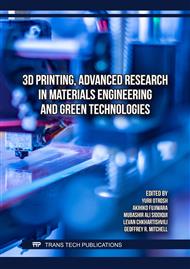[1]
J. Davidovits, Carbon-dioxide greenhouse-warming: What future for Portland cement, in: Proc. Emerging Technol. Symp. Cem. Concr. Global Environ., Portland Cem. Assoc., Chicago, 1993, pp.1-21.
Google Scholar
[2]
P. K. Mehta, Greening of the concrete industry for sustainable development, Concrete Int. 23 (7) (2002) 23-38.
Google Scholar
[3]
A.L. Tau, E.I. Edoun, Ch. Mbohwa, A. Pradhan, Green cement manufacturing in South Africa through utilization of supplementary cementitious materials – Market assessment, in: Proc. 2nd Australian Int. Conf. Ind. Eng. Operat. Manag., IEOM Soc. Int., Melbourne, 2023, pp.415-428.
DOI: 10.46254/au02.20230102
Google Scholar
[4]
G. Gaurav, Sh.C. Kandpal, D. Mishra, N. Kotoky, A comprehensive review on fly ash-based geopolymer: A pathway for sustainable future, J. Sustain. Cem. Based Mater. 13 (1) (2024) 100-144.
DOI: 10.1080/21650373.2023.2258122
Google Scholar
[5]
N. Anil, Compressive strength variation of alkali activated fly ash/slag concrete with different NaOH concentrations and sodium silicate to sodium hydroxide ratios, J. Sustain. Constr. Mater. Technol. 4 (2) (2019) 351-360.
DOI: 10.29187/jscmt.2019.39
Google Scholar
[6]
A. Palomo, M.W. Grutzeck, M.T. Blanco, Alkali-activated fly ash cement for future, Cem. Concr. Res. 29 (8) (1999) 1323-1329.
DOI: 10.1016/s0008-8846(98)00243-9
Google Scholar
[7]
F. Vazquez–Rodriguez, N. Elizondo, M. Montes–Gonzalez, C. Gomez–Rodriguez, Y. Gonzalez–Carranza, A.M. Guzman, E.A. Rodriguez, Microstructural and mechanical characteristics of alkali-activated binders composed of milled fly ash and granulated blast furnace slag with μ-limestone addition, Materials 16 (2023) 3818 (1-24).
DOI: 10.3390/ma16103818
Google Scholar
[8]
D.E. Angulo–Ramirez, W.G. Valencia–Saavedra, R.M. de Gutierrez, Alkali-activated concretes based on fly ash and blast furnace slag: Compressive strength, water absorption and chloride permeability, Ingenieria e Investigacion 40 (2) (2020) 72-80.
DOI: 10.15446/ing.investig.v40n2.83893
Google Scholar
[9]
S. Arafa, A. Milad, N.I. Yusoff, N. Al-Ansari, Z.M. Yaseen, Investigation into the permeability and strength of pervious geopolymer concrete containing coated biomass aggregate material, J. Mater. Res. Technol. 15 (2021) 2075-2087.
DOI: 10.1016/j.jmrt.2021.09.045
Google Scholar
[10]
Sh. Qaidi, H.M. Najm, S.M. Abed, H.U. Ahmed, H. Al Dughaishi, J. Al Lawati, M.M. Sabri, F. Alkhatib, A. Milad, Fly ash-based geopolymer composites: A review of the compressive strength and microstructure analysis, Materials 15 (20) (2022) 7098 (1-40).
DOI: 10.3390/ma15207098
Google Scholar
[11]
O.M.M. Elbasir, M.A.M. Johari, Z.A. Ahmad, N.S. Mashaan, A. Milad, The compressive strength and microstructure of alkali-activated mortars utilizing by-product-based binary-blended precursors, Appl. Mech. 4 (3) (2023) 885-898.
DOI: 10.3390/applmech4030046
Google Scholar
[12]
X. Gang, S. Xianming, Characteristics and applications of fly ash as a sustainable construction material: A state-of-the-art review, Resour. Conser. Recyc. 136 (2018) 95-109.
Google Scholar
[13]
B.G. Kutchko, A.G. Kim, Fly ash characterization by SEM–EDS, Fuel 85 (17/18) (2006) 2537-2544.
DOI: 10.1016/j.fuel.2006.05.016
Google Scholar
[14]
S. Kumar, R. Kumar, Mechanical activation of fly ash: Effect on reaction, structure and properties of resulting geopolymer, Ceram. Int. 37 (2) (2011) 533-541.
DOI: 10.1016/j.ceramint.2010.09.038
Google Scholar
[15]
K. Kato, Y. Xin, T. Hitomi, T. Shirai, Surface modification of fly ash by mechano-chemical treatment, Ceram. Int. 45 (1) (2019) 849-853.
DOI: 10.1016/j.ceramint.2018.09.254
Google Scholar
[16]
A. Fernandez–Jimenez, I. Garcia–Lodeiro, O. Maltseva, A. Palomo, Mechanical-chemical activation of coal fly ashes: An effective way for recycling and make cementitious materials, Front. Mater. 6 (2019) 51 (1-12).
DOI: 10.3389/fmats.2019.00051
Google Scholar
[17]
A.M. Kalinkin, E.V. Kalinkina, E.A. Krugliak, A.G. Ivanova, Synthesis of geopolymers incorporating mechanically activated fly ash blended with alkaline earth carbonates: A comparative analysis, Minerals 14 (6) (2024) 726 (1-13).
DOI: 10.3390/min14070726
Google Scholar
[18]
L. Parfenova, V. Bozylev, A. Shvedov, M. Vysotskaya, Modes and methods for activation ash waste thermal power plants, Bull. Polotsk State Univ. F 8 (2016) 57-60.
Google Scholar
[19]
E. Shapakidze, M. Avaliani, M. Nadirashvili, V. Maisuradze, I. Gejadze, T. Petriashvili, Preparation of geopolymer materials based on activated fly ash, in: Proc. 12th Int. Sci.-Tech. Conf. Adv. Petrol. Gas Ind. Petrochem., Lviv Polytech. Natl. Univ., Lviv, 2024, pp.173-176.
DOI: 10.52340/ns.2020.06
Google Scholar


